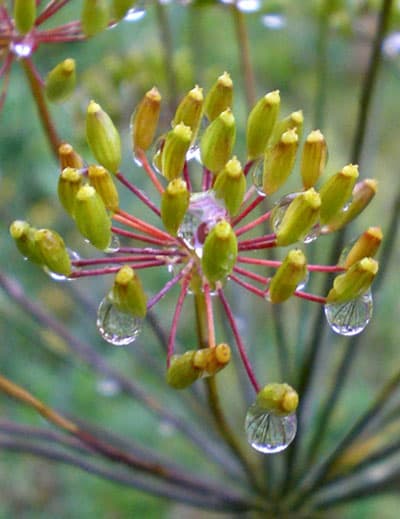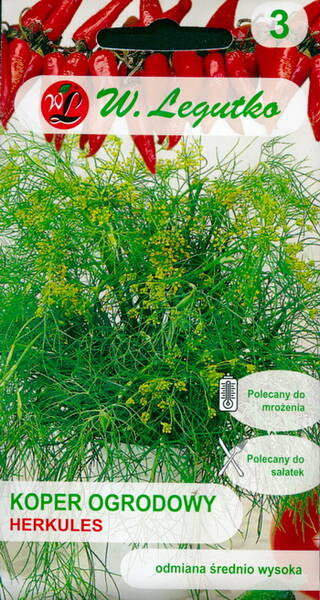Medium early variety (until tender: 40-45 days, before flowering: 65-70 days).
Agrotechnics:
Dill is a cold-resistant, light-loving plant. Prefers fertile, moist soils.
Sowing: from mid-March to July, dill seeds are sown on the prepared soil without embedding, but with mandatory mulching with peat 2-3 cm. Seedlings appear on 10-15 days.
To obtain earlier greens, dill is sown before winter on frozen soil and covered with peat also 2-3 cm.
Care: consists in loosening row spacings, weeding, watering and feeding. For feeding throughout the growing season, it is recommended to use a complex water-soluble mineral fertilizer.
Harvesting: May-September. With multiple sowing and harvesting, the yield can reach up to 10 kg of green mass per 1 sq. m, for spices - up to 7 kg per 1 sq. m.
1 gramm = 590-650 seeds.

Dill.
* Dill is planted by almost all gardeners, but not everyone grows green and thick. Sometimes only thin blades of a yellowish or reddish hue appear on the beds. And it happens that dill does not come up at all.
This seemingly uncomplicated culture has its own secrets. Dill grows green only on soils fertilized with organic fertilizers. Before sowing, the soil is not lime and ash is not added, otherwise the plantings will turn red. You can not sow dill in a shaded place: the plants will stretch out and will be pale. And so that the dill does not go into the arrow early, they try not to overdry the soil, they always keep it moist.
Rinse the seeds in hot water before planting to remove the anti-germination essential oil. Check germination by soaking them for 2-3 days in a wet cloth. If the seeds do not hatch during this time, use them as a seasoning, they are not suitable for planting.
Fertilize the soil with humus (1/3 bucket per 1 sq. M), add 1 tbsp. spoon of nitrophoska or Kemira-wagon fertilizer. Instead of humus, you can shed furrows with a diluted mullein in a ratio of 1:10.
You can sow dill very early, on April 1-10, right on the ice crust, but only dry seeds are used for such planting.
Most often, dill is sown on April 20-25. It is better to sow it not in one line, but in a wide furrow of 5 cm: the seeds are scattered in it in a "zigzag", then the plants will not fall when thinning.
The furrows are pre-watered, dill is sown to a depth of 1-2 cm. The plantings are covered with humus and no longer watered. Plants are thinned out in the phase of 2-3 true leaves, leaving a distance of 8-10 cm between them.
During growth, dill is not fed. Water it once every seven days, and in hot, dry weather - twice a week.
The harvest ripens in 3-4 weeks after germination, when the greens reach 15-20 cm. They pull it straight out from the root.
Dill is most fragrant during the budding period, when its top thickens, but it does not bloom yet. At this time, it is dried, frozen, pickled or scented with vinegar.
Fully ripened umbrellas are cut for seeds. They are stored in a well-sealed jar, germination lasts 2-3 years.
Repeated sowing of dill is carried out every 15-20 days, the last sowing is recommended no later than August 20. Before sowing, the seeds are heated for 30 minutes in hot water (temperature + 48 + 50 ° C), then they are cooled in cold water and dried.












